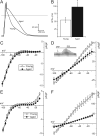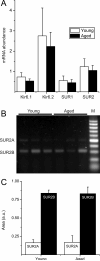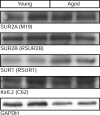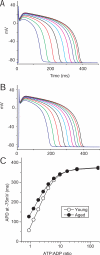Alterations in ventricular K(ATP) channel properties during aging
- PMID: 23173756
- PMCID: PMC3551995
- DOI: 10.1111/acel.12033
Alterations in ventricular K(ATP) channel properties during aging
Abstract
Coronary heart disease remains the principle cause of mortality in the United States. During aging, the efficiency of the cardiovascular system is decreased and the aged heart is less tolerant to ischemic injury. ATP-sensitive K(+) (K(ATP)) channels protect the myocardium against ischemic damage. We investigated how aging affects cardiac K(ATP) channels in the Fischer 344 rat model. Expression of K(ATP) channel subunit mRNA and protein levels was unchanged in hearts from 26-month-old vs. 4-month-old rats. Interestingly, the mRNA expression of several other ion channels (> 80) was also largely unchanged, suggesting that posttranscriptional regulatory mechanisms occur during aging. The whole-cell K(ATP) channel current density was strongly diminished in ventricular myocytes from aged male rat hearts (also observed in aged C57BL/6 mouse myocytes). Experiments with isolated patches (inside-out configuration) demonstrated that the K(ATP) channel unitary conductance was unchanged, but that the inhibitory effect of cytosolic ATP on channel activity was enhanced in the aged heart. The mean patch current was diminished, consistent with the whole-cell data. We incorporated these findings into an empirical model of the K(ATP) channel and numerically simulated the effects of decreased cytosolic ATP levels on the human action potential. This analysis predicts lesser activation of K(ATP) channels by metabolic impairment in the aged heart and a diminished action potential shortening. This study provides insights into the changes in K(ATP) channels during aging and suggests that the protective role of these channels during ischemia is significantly compromised in the aged individual.
© 2012 The Authors Aging Cell © 2012 Blackwell Publishing Ltd/Anatomical Society of Great Britain and Ireland.
Figures






Similar articles
-
Impaired activation of ATP-sensitive K+ channels in endocardial myocytes from left ventricular hypertrophy.Am J Physiol Heart Circ Physiol. 2007 Dec;293(6):H3643-9. doi: 10.1152/ajpheart.01357.2006. Epub 2007 Oct 5. Am J Physiol Heart Circ Physiol. 2007. PMID: 17921319
-
Identification and properties of ATP-sensitive potassium channels in myocytes from rabbit Purkinje fibres.Cardiovasc Res. 1999 Nov;44(2):356-69. doi: 10.1016/s0008-6363(99)00218-7. Cardiovasc Res. 1999. PMID: 10690312
-
Reduction in number of sarcolemmal KATP channels slows cardiac action potential duration shortening under hypoxia.Biochem Biophys Res Commun. 2011 Dec 2;415(4):637-41. doi: 10.1016/j.bbrc.2011.10.125. Epub 2011 Nov 3. Biochem Biophys Res Commun. 2011. PMID: 22079630 Free PMC article.
-
Characterization of inwardly rectifying K+ channel in human cardiac myocytes. Alterations in channel behavior in myocytes isolated from patients with idiopathic dilated cardiomyopathy.Circulation. 1995 Jul 15;92(2):164-74. doi: 10.1161/01.cir.92.2.164. Circulation. 1995. PMID: 7600647
-
Measuring and evaluating the role of ATP-sensitive K+ channels in cardiac muscle.J Mol Cell Cardiol. 2012 Mar;52(3):596-607. doi: 10.1016/j.yjmcc.2011.12.012. Epub 2012 Jan 3. J Mol Cell Cardiol. 2012. PMID: 22245446 Free PMC article. Review.
Cited by
-
Ionic current changes underlying action potential repolarization responses to physiological pacing and adrenergic stimulation in adult rat ventricular myocytes.Physiol Rep. 2023 Jul;11(14):e15766. doi: 10.14814/phy2.15766. Physiol Rep. 2023. PMID: 37495507 Free PMC article.
-
Cardiovascular KATP channels and advanced aging.Pathobiol Aging Age Relat Dis. 2016 Oct 11;6:32517. doi: 10.3402/pba.v6.32517. eCollection 2016. Pathobiol Aging Age Relat Dis. 2016. PMID: 27733235 Free PMC article. Review.
-
ABCC9/SUR2 in the brain: Implications for hippocampal sclerosis of aging and a potential therapeutic target.Ageing Res Rev. 2015 Nov;24(Pt B):111-25. doi: 10.1016/j.arr.2015.07.007. Epub 2015 Jul 28. Ageing Res Rev. 2015. PMID: 26226329 Free PMC article. Review.
-
Overexpression of adiponectin improves neurobehavioral outcomes after focal cerebral ischemia in aged mice.CNS Neurosci Ther. 2013 Dec;19(12):969-77. doi: 10.1111/cns.12198. Epub 2013 Oct 25. CNS Neurosci Ther. 2013. PMID: 24164711 Free PMC article.
-
Separate and combined effects of KCa and KATP channel blockade with NOS inhibition on cutaneous vasodilation and sweating in older men during heat stress.Am J Physiol Regul Integr Comp Physiol. 2019 Jul 1;317(1):R113-R120. doi: 10.1152/ajpregu.00075.2019. Epub 2019 May 15. Am J Physiol Regul Integr Comp Physiol. 2019. PMID: 31091157 Free PMC article.
References
-
- Andersen CL, Jensen JL, Orntoft TF. Normalization of real-time quantitative reverse transcription-PCR data: a model-based variance estimation approach to identify genes suited for normalization, applied to bladder and colon cancer data sets. Cancer Research. 2004;64:5245–5250. - PubMed
-
- Boengler K, Schulz R, Heusch G. Loss of cardioprotection with ageing. Cardiovasc Res. 2009;83:247–261. - PubMed
Publication types
MeSH terms
Substances
Grants and funding
LinkOut - more resources
Full Text Sources
Medical

